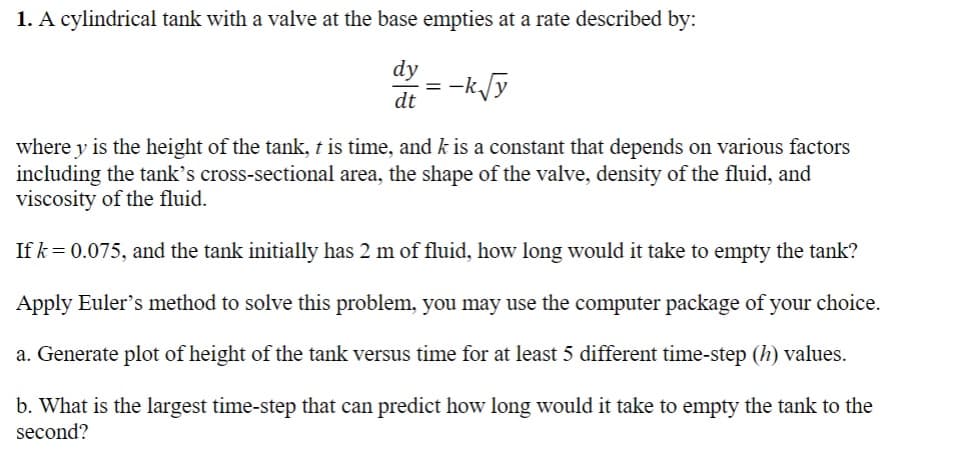1. A cylindrical tank with a valve at the base empties at a rate described by: dy dt = -k√y where y is the height of the tank, t is time, and k is a constant that depends on various factors including the tank's cross-sectional area, the shape of the valve, density of the fluid, and viscosity of the fluid. If k= 0.075, and the tank initially has 2 m of fluid, how long would it take to empty the tank? Apply Euler's method to solve this problem, you may use the computer package of your choice. a. Generate plot of height of the tank versus time for at least 5 different time-step (h) values. b. What is the largest time-step that can predict how long would it take to empty the tank to the second?
1. A cylindrical tank with a valve at the base empties at a rate described by: dy dt = -k√y where y is the height of the tank, t is time, and k is a constant that depends on various factors including the tank's cross-sectional area, the shape of the valve, density of the fluid, and viscosity of the fluid. If k= 0.075, and the tank initially has 2 m of fluid, how long would it take to empty the tank? Apply Euler's method to solve this problem, you may use the computer package of your choice. a. Generate plot of height of the tank versus time for at least 5 different time-step (h) values. b. What is the largest time-step that can predict how long would it take to empty the tank to the second?
Introduction to Chemical Engineering Thermodynamics
8th Edition
ISBN:9781259696527
Author:J.M. Smith Termodinamica en ingenieria quimica, Hendrick C Van Ness, Michael Abbott, Mark Swihart
Publisher:J.M. Smith Termodinamica en ingenieria quimica, Hendrick C Van Ness, Michael Abbott, Mark Swihart
Chapter1: Introduction
Section: Chapter Questions
Problem 1.1P
Related questions
Question
100%

Transcribed Image Text:1. A cylindrical tank with a valve at the base empties at a rate described by:
dy
dt
=
-k√y
where y is the height of the tank, t is time, and k is a constant that depends on various factors
including the tank's cross-sectional area, the shape of the valve, density of the fluid, and
viscosity of the fluid.
If k = 0.075, and the tank initially has 2 m of fluid, how long would it take to empty the tank?
Apply Euler's method to solve this problem, you may use the computer package of your choice.
a. Generate plot of height of the tank versus time for at least 5 different time-step (h) values.
b. What is the largest time-step that can predict how long would it take to empty the tank to the
second?
Expert Solution
Step 1
Time required to empty the tank is to be calculated.
Step by step
Solved in 3 steps with 2 images

Recommended textbooks for you

Introduction to Chemical Engineering Thermodynami…
Chemical Engineering
ISBN:
9781259696527
Author:
J.M. Smith Termodinamica en ingenieria quimica, Hendrick C Van Ness, Michael Abbott, Mark Swihart
Publisher:
McGraw-Hill Education

Elementary Principles of Chemical Processes, Bind…
Chemical Engineering
ISBN:
9781118431221
Author:
Richard M. Felder, Ronald W. Rousseau, Lisa G. Bullard
Publisher:
WILEY

Elements of Chemical Reaction Engineering (5th Ed…
Chemical Engineering
ISBN:
9780133887518
Author:
H. Scott Fogler
Publisher:
Prentice Hall

Introduction to Chemical Engineering Thermodynami…
Chemical Engineering
ISBN:
9781259696527
Author:
J.M. Smith Termodinamica en ingenieria quimica, Hendrick C Van Ness, Michael Abbott, Mark Swihart
Publisher:
McGraw-Hill Education

Elementary Principles of Chemical Processes, Bind…
Chemical Engineering
ISBN:
9781118431221
Author:
Richard M. Felder, Ronald W. Rousseau, Lisa G. Bullard
Publisher:
WILEY

Elements of Chemical Reaction Engineering (5th Ed…
Chemical Engineering
ISBN:
9780133887518
Author:
H. Scott Fogler
Publisher:
Prentice Hall


Industrial Plastics: Theory and Applications
Chemical Engineering
ISBN:
9781285061238
Author:
Lokensgard, Erik
Publisher:
Delmar Cengage Learning

Unit Operations of Chemical Engineering
Chemical Engineering
ISBN:
9780072848236
Author:
Warren McCabe, Julian C. Smith, Peter Harriott
Publisher:
McGraw-Hill Companies, The